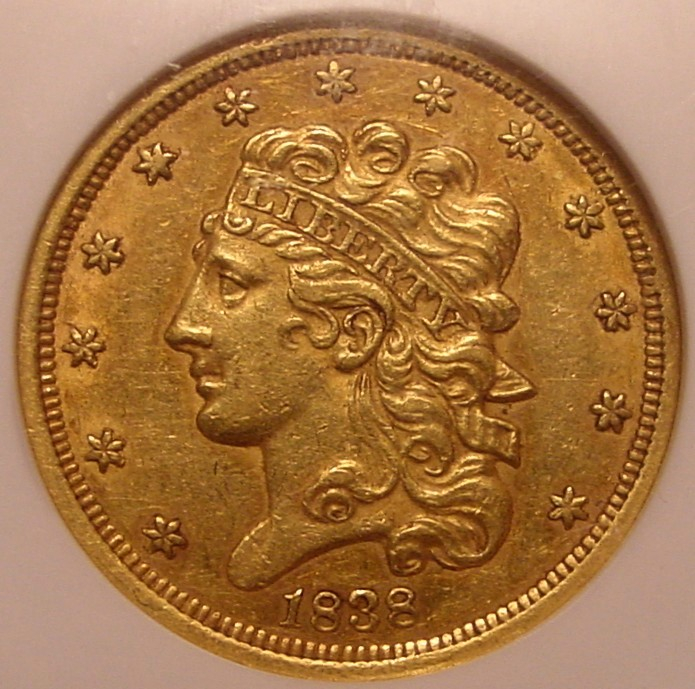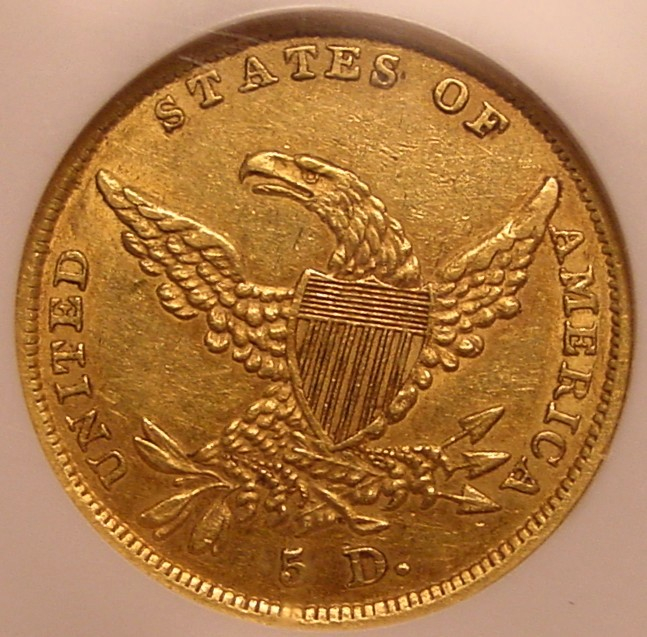Classic Head Gold Collection, Part 13, 1838 Half Eagle


Mintage 286,588
Estimated Number of Survivors 700
The 1838 half eagle is a moderately scarce coin. It ranks above the 1834 Plain 4, 1836 and by a narrow margin 1835 half eagles in rarity. It is decidedly more common than the 1837 and its far more glamorous Charlotte and Dahlonega “golden sisters.” The coin is generally available in EF and AU, but Mint State examples are scarce.
The coin displayed about is graded NGC AU-58, CAC. After comparing this piece with the 1835 half eagle in this exhibit, I have concluded that AU-55 might be a more accurate grade. Still the piece has smooth surfaces and satiny luster, and it has an original look that many modern collectors find appealing.
I purchased this piece at the 2017 Winter FUN, partly out of frustration. I probably should have waited for a better example. I couldn't find much of anything at that show that was on my list. This was the first major at which I saw a big drop in the quality of the offerings that were on the bourse.
Comments
Still a nice gold coin Bill.... any ideas about the drop in quality at such a large show? Are the good coins all being tight now? Cheers, RickO
The 1838 half eagle has another interesting aspect. More than 100,000 half
eagles were struck that year at Philadelphia from the Smithson bequest. The
money was later used to create the Smithsonian.
It was also the first Classic Head $5 made using a reducing lathe. There are two obverses and two reverses that comprise two die marriages. The second 8 in the date is placed minutely different. An easier way to distinguish the two obverses is to look for a center dot. One obverse has it, one does not. The OP coin has a center dot inside the ear.
I think that it as others have posted. A lot of "strong hands" are buying the good coins that have eye appeal and are properly graded. The "strong hands" are buying and holding, not selling.
The auctions also yield better results for those who are selling. Dealers shoot themselves in the foot when they make low ball offers at the shows. If you have got nice coins, there is no sense in going to a show to get beat up by dealers who looking to buy everything cheap.
@BillJones ... Thanks Bill.. and good advice about selling good gold coins... Cheers, RickO
James Smithson, an English scientist that never visited the United States, donated over 100,000 sovereigns for the increase and diffusion of knowledge. That donation was used to build the Smithsonian. The sovereigns, mostly 1838 issues if I remember correctly, were melted and coined into gold half Eagles and Eagles. The Smithsonian has two examples of the 1838 sovereigns, but cannot say for sure whether they were part of Smithson's donation or obtained later to represent the gift. The $10 Eagle in the Smithsonian collection was coined from the original sovereigns.
Back to Bill's coin - very nice. I only wish I had Bill's eye for coins.